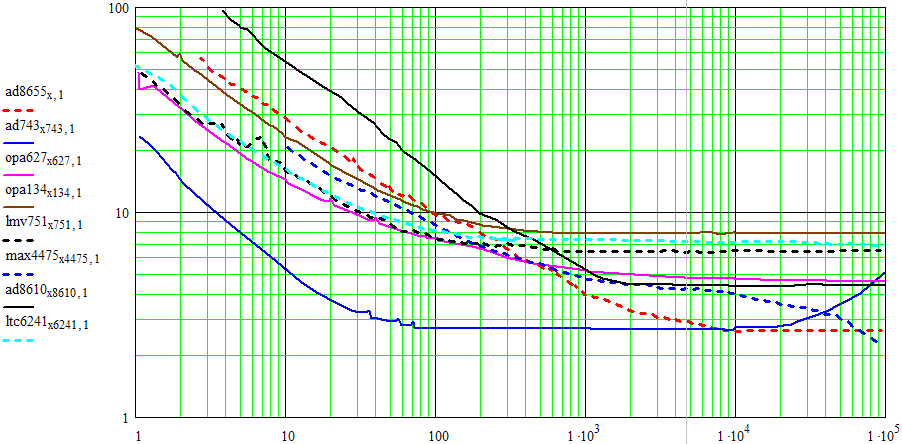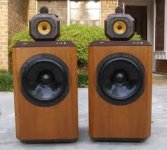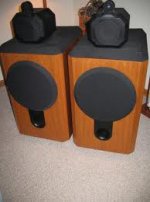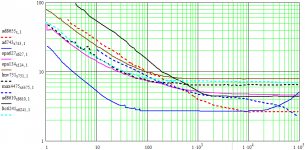(B&W801) are very neutral and revealing of amplifier differences (or to put it another way: absolute b#stards to drive Not that this should matter to the preamp...)
Nice speakers. I have the 703's which are a bit of a tough cookie impedance wise.
Too many posts to look back on but did you try just hanging a 10k pot off the tone stages and feeding the amp from that bypassing the active stage ?
Also, although designing for low noise by reducing circuit impedance may have its own appeal it also undeniably taxes the opamp stages. It would be interesting to try a high impedance version (with 10 or even 100k pots and appropriate redesign) and sacrifice a few db of noise to compare.
I think you should start trusting your own judgement
Measurements count for nothing when you can consistently, honestly and reliably say you don't like what you are hearing.
Nice speakers. I have the 703's which are a bit of a tough cookie impedance wise.
Too many posts to look back on but did you try just hanging a 10k pot off the tone stages and feeding the amp from that bypassing the active stage ?
Also, although designing for low noise by reducing circuit impedance may have its own appeal it also undeniably taxes the opamp stages. It would be interesting to try a high impedance version (with 10 or even 100k pots and appropriate redesign) and sacrifice a few db of noise to compare.
I think you should start trusting your own judgement
Measurements count for nothing when you can consistently, honestly and reliably say you don't like what you are hearing.
Unfortunately they aren't the current model - they're the original 801 from the early '80s with sealed box 12" bass. 85dB/W and with an impedance curve like a rollercoaster... they eat watts and need a large power amp to sound their best.
I bought them second hand and have fully restored them. They aren't even close to as good as the current model, but they still do some things very well and are far better than anything I can afford new at the moment. They were state of the art back then and were designed as a studio monitor and indeed were used by most of the major recording labels for many years. They are extremely accurate tonally and can play very loud without obvious compression if you have enough watts on tap. They also get the scale and weight of an orchestra right in a way that smaller drivers in thinner cabinets never seem to (ie they don't suffer diffraction loss in the lower midrange).
I've heard the 703, very nice and probably what I'd buy new too. Bonsai if upgrading the current 802 is amazingly good too, and quite a bit less than the 801. I have a few power amps to choose from, the usual is the Leach amp as it makes music and I forget about amplifier shortcomings. I also have a Studio 350 designed by Silicon Chip magazine (details can be found on this forum IIRC) which is hard to fault for such a simple design based around an old topology. And there's some assorted others like the old ETI 5000 which I still have a soft spot for. The Leach amp only just has enough power, so I'm working on a PCB design for the Leach Super amp 300W version (intermittently when time permits) to update it for TO-264 ouput devices.
Mooly I haven't tried bypassing the active gain control stage yet but intend to as soon as I get a chance.
Thanks for the advice, the engineer in me keeps wanting to correlate what I hear with measurements but you're right, I should be more pragmatic about sticking with what I like since I'm only building stuff for my own use. I've done this with the Leach amp - its THD perfomance is hardly impressive at HF and yet to me it's somehow more natural and much better at reproducing the tone of strings etc than other very low THD designs so I've just stuck with it over the years.
I bought them second hand and have fully restored them. They aren't even close to as good as the current model, but they still do some things very well and are far better than anything I can afford new at the moment. They were state of the art back then and were designed as a studio monitor and indeed were used by most of the major recording labels for many years. They are extremely accurate tonally and can play very loud without obvious compression if you have enough watts on tap. They also get the scale and weight of an orchestra right in a way that smaller drivers in thinner cabinets never seem to (ie they don't suffer diffraction loss in the lower midrange).
I've heard the 703, very nice and probably what I'd buy new too. Bonsai if upgrading the current 802 is amazingly good too, and quite a bit less than the 801. I have a few power amps to choose from, the usual is the Leach amp as it makes music and I forget about amplifier shortcomings. I also have a Studio 350 designed by Silicon Chip magazine (details can be found on this forum IIRC) which is hard to fault for such a simple design based around an old topology. And there's some assorted others like the old ETI 5000 which I still have a soft spot for. The Leach amp only just has enough power, so I'm working on a PCB design for the Leach Super amp 300W version (intermittently when time permits) to update it for TO-264 ouput devices.
Mooly I haven't tried bypassing the active gain control stage yet but intend to as soon as I get a chance.
Thanks for the advice, the engineer in me keeps wanting to correlate what I hear with measurements but you're right, I should be more pragmatic about sticking with what I like since I'm only building stuff for my own use. I've done this with the Leach amp - its THD perfomance is hardly impressive at HF and yet to me it's somehow more natural and much better at reproducing the tone of strings etc than other very low THD designs so I've just stuck with it over the years.
Nice to know Nico  I think the original design looks better - I just love the cabinet and grille designs - but I haven't compared the sound with the new models side by side. Still I'm very happy with mine. I think the Kevlar midrange driver (the first driver to use this material and be designed using laser interferometry according the original blurb) is the key to their success.
I think the original design looks better - I just love the cabinet and grille designs - but I haven't compared the sound with the new models side by side. Still I'm very happy with mine. I think the Kevlar midrange driver (the first driver to use this material and be designed using laser interferometry according the original blurb) is the key to their success.
There were a few revisions to the original 801 - mine are the original but the design was updated to series 2 in about '87 which brought aluminium tweeters, reflex loading, a matrix cabinet and 6th order electronic bass alignment (see photo) which got them to -3dB @ 20Hz! I have some friends with these and I think they are a bit better than the original in most ways. I think there was also a series 3 released in the '90s which simplified the crossover (the earlier series are both 4th order and very complex, plus poorly laid out with regard to inductor coupling - I spent ages working out the best layout to minimise it when I did the rebuild).
There were a few revisions to the original 801 - mine are the original but the design was updated to series 2 in about '87 which brought aluminium tweeters, reflex loading, a matrix cabinet and 6th order electronic bass alignment (see photo) which got them to -3dB @ 20Hz! I have some friends with these and I think they are a bit better than the original in most ways. I think there was also a series 3 released in the '90s which simplified the crossover (the earlier series are both 4th order and very complex, plus poorly laid out with regard to inductor coupling - I spent ages working out the best layout to minimise it when I did the rebuild).
Attachments
Guys, let's get back on topic, these speaker discussions belong in the multi-way forum if you wish to continue them.
Judging by the equipment that these members use, validates their arguments of how certain component changes effects their perceived performance of said pre-amp.
If any of these honorable members were using plastic desktop speakers from dubious origin, would anyone care about their perceived opinion?
Last edited:
Thanks Nico 
Guys, apologies for the brief diversion, but if you care to read back a little way you will see that the topic is relevant to the recent discussion on why I'm not happy with the sound of the preamp - the question on what ancilliary equipment I'm using was asked so I was answering this. If this recent discussion isn't relevant to the topic, then what is? I was expecting it to sound really good since it is carefully designed by a very respected designer and measures impeccably, but it doesn't. Is this not an interesting situation that could provide a learning experience for those that are prepared to trust their ears as well as their test instruments? What is the purpose of this forum otherwise? I'm not expecting Mr Self to take any notice of my ramblings and change his design philosophy and certainly do not intend any disrespect, just wanting to share my honest opinion for what it's worth and see what others think. I would really like to understand why.
I'm not expecting Mr Self to take any notice of my ramblings and change his design philosophy and certainly do not intend any disrespect, just wanting to share my honest opinion for what it's worth and see what others think. I would really like to understand why.
Guys, apologies for the brief diversion, but if you care to read back a little way you will see that the topic is relevant to the recent discussion on why I'm not happy with the sound of the preamp - the question on what ancilliary equipment I'm using was asked so I was answering this. If this recent discussion isn't relevant to the topic, then what is? I was expecting it to sound really good since it is carefully designed by a very respected designer and measures impeccably, but it doesn't. Is this not an interesting situation that could provide a learning experience for those that are prepared to trust their ears as well as their test instruments? What is the purpose of this forum otherwise?
 I'm not expecting Mr Self to take any notice of my ramblings and change his design philosophy and certainly do not intend any disrespect, just wanting to share my honest opinion for what it's worth and see what others think. I would really like to understand why.
I'm not expecting Mr Self to take any notice of my ramblings and change his design philosophy and certainly do not intend any disrespect, just wanting to share my honest opinion for what it's worth and see what others think. I would really like to understand why.Mooly and Dirkwright,
My question given your comment is which opamps would you use in these applications as you don't seem to like the 5532 or even the LM4562? Whose chips would you like to see used and at what price differential are you talking. The 5532 chip is only about a dollar a piece US and the LM4562 chips are not that much either, mote than the 5532 though. I'd like to know what your selections would be.
Steven
My question given your comment is which opamps would you use in these applications as you don't seem to like the 5532 or even the LM4562? Whose chips would you like to see used and at what price differential are you talking. The 5532 chip is only about a dollar a piece US and the LM4562 chips are not that much either, mote than the 5532 though. I'd like to know what your selections would be.
Steven
Hi Steven.
I'd probably go for the OPA2134 FET opamp which has given me good results generally.
I would always back that up by saying that you must listen and use your own judgement.
The TLE2072 could be an "interesting" choice too because of its very high drive capability. Certainly where the design pushes the opamps as here.
There's no right and wrong answer to this. You have to listen for yourself. Sometimes using different opamps for different parts of the circuit can yield better sonic results too.
For a one off design the cost of the opamps is of little concern, particularly when total costs of the complete project are factored in.
I'd probably go for the OPA2134 FET opamp which has given me good results generally.
I would always back that up by saying that you must listen and use your own judgement.
The TLE2072 could be an "interesting" choice too because of its very high drive capability. Certainly where the design pushes the opamps as here.
There's no right and wrong answer to this. You have to listen for yourself. Sometimes using different opamps for different parts of the circuit can yield better sonic results too.
For a one off design the cost of the opamps is of little concern, particularly when total costs of the complete project are factored in.
Mooly,
I'll have to take a look at the TLE from TI and see how that is comparing also. With TI having both their and Nationals line together this is getting both interesting and a little confused at the same time. At some point what will they keep and what will go away because of the crossover of devices. Time will tell,
Steven
I'll have to take a look at the TLE from TI and see how that is comparing also. With TI having both their and Nationals line together this is getting both interesting and a little confused at the same time. At some point what will they keep and what will go away because of the crossover of devices. Time will tell,
Steven
MagiocBox,
I took a look at this TLE214x opamp and boy does it have a wide bandwidth. I am assuming that this isn't necessary and probably isn't that important as we would use a low pass cutoff low enough that this has no real advantage. So is the noise floor the most important single specification besides slew rating that you would look for in a unity application? All else being beyond the electrical requirements of an active audio crossover am I getting this correct? What other things actually affect the sound quality of the opamps if we are using the devices within design specifications and aren't doing something inappropriate in the circuit like voltage noise from incorrect resistance values. I have read Self on crossovers and he mostly talks about Johnson noise from the resistors being the second greatest sound source besides the initial devices noise floor. The price on any of these opamps are so close together that this doesn't become a determinate factor. The choices between the Burr-Brown, TI, National, and even Linear Devices are like trying to pick a needle out of the proverbial haystack. I guess if money was no object there are some opamps that are better than others, but since we are only using them for audio and not RF or something at much higher frequency this becomes like picking if you like the Ferrari better than the Lamborghini when they share the same engine........
I took a look at this TLE214x opamp and boy does it have a wide bandwidth. I am assuming that this isn't necessary and probably isn't that important as we would use a low pass cutoff low enough that this has no real advantage. So is the noise floor the most important single specification besides slew rating that you would look for in a unity application? All else being beyond the electrical requirements of an active audio crossover am I getting this correct? What other things actually affect the sound quality of the opamps if we are using the devices within design specifications and aren't doing something inappropriate in the circuit like voltage noise from incorrect resistance values. I have read Self on crossovers and he mostly talks about Johnson noise from the resistors being the second greatest sound source besides the initial devices noise floor. The price on any of these opamps are so close together that this doesn't become a determinate factor. The choices between the Burr-Brown, TI, National, and even Linear Devices are like trying to pick a needle out of the proverbial haystack. I guess if money was no object there are some opamps that are better than others, but since we are only using them for audio and not RF or something at much higher frequency this becomes like picking if you like the Ferrari better than the Lamborghini when they share the same engine........
recent monolithic fet op amp noise still isn't definitively ahead of OPA627 or AD743
but if you can deal with surface mount parts there are substantial improvements in most other parameters available in the last decade's newer op amps
there are a handful of devices aimed at OPA627 replacement
and a fairly low noise, not as costly OP164x series
for some audio applications A weighting makes low frequency noise performance less important
then there are also some CMOS possibilities

probably needs updating but I tried plotting a few fet and cmos op amp noise together:
http://www.diyaudio.com/forums/solid-state/68793-new-interesting-cmos-op-amps-2.html#post843381
but if you can deal with surface mount parts there are substantial improvements in most other parameters available in the last decade's newer op amps
there are a handful of devices aimed at OPA627 replacement
and a fairly low noise, not as costly OP164x series
for some audio applications A weighting makes low frequency noise performance less important
then there are also some CMOS possibilities
probably needs updating but I tried plotting a few fet and cmos op amp noise together:
http://www.diyaudio.com/forums/solid-state/68793-new-interesting-cmos-op-amps-2.html#post843381
Attachments
Last edited:
Jcx,
Graphs, I love those..... The AD743 looks to be the clear winner on that graph. I know about those on the sonic side, to easy to fudge a frequency response plot by just changing the pen plotter paper feed rate or the pen response. I am not saying you did that, just saying I have seen that many times on response plots that look so nice and smooth and then you do that yourself and see all the information come out that was just rounded out. Nothing like a good waterfall plot on a driver with a good laboratory response microphone. I'll take a look at that AD chip.
Graphs, I love those..... The AD743 looks to be the clear winner on that graph. I know about those on the sonic side, to easy to fudge a frequency response plot by just changing the pen plotter paper feed rate or the pen response. I am not saying you did that, just saying I have seen that many times on response plots that look so nice and smooth and then you do that yourself and see all the information come out that was just rounded out. Nothing like a good waterfall plot on a driver with a good laboratory response microphone. I'll take a look at that AD chip.
- Home
- Source & Line
- Analog Line Level
- New Doug Self pre-amp design...


